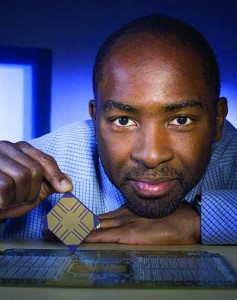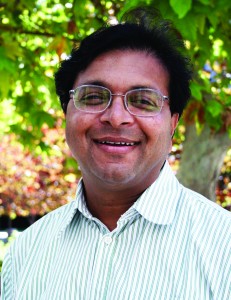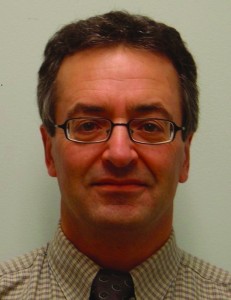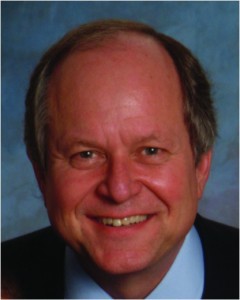Each year the Department of Electrical and Computer Engineering, in conjunction with the Information Infrastructure Institute (iCUBE), presents a Distinguished Lecture Series, which brings prominent researchers in the electrical, computer, and software engineering fields to campus. All lectures take place from 1:10 to 2 p.m. at the Alliant Energy-Lee Liu Auditorium in Howe Hall, unless otherwise noted.
April 6
TAMING HETEROGENEOUS PARALLELISM WITH DOMAIN SPECIFIC LANGUAGES
Kunle Olukotun, Director of the Pervasive Parallelism Laboratory and Professor, Department of Electrical Engineering and Department of Computer Science, Stanford University
Abstract: Computing systems are becoming increasingly parallel and heterogeneous; however, exploiting the full capability of these architectures is complicated because it requires application code to be developed with multiple programming models. A much more productive single programming model approach to heterogeneous parallelism uses domain specific languages (DSLs). DSLs provide high-level abstractions, which improve programmer productivity and enable transformations to high performance parallel code. In this talk, Olukotun will discuss the DSL approach to heterogeneous parallelism, show example DSLs that provide both high productivity and performance, and describe Delite, a framework that simplifies the development of DSLs embedded in Scala.
Speaker biography: Olukotun is a professor of electrical engineering and computer science at Stanford University. He is best known as a pioneer in chip multiprocessor (CMP) design and the leader of the Stanford Hydra CMP research project. Olukotun founded Afara Websystems to develop high-throughput, low-power server systems with CMP technology. The Afara microprocessor, called Niagara, was acquired by Sun Microsystems. Niagara-derived processors now power all Oracle SPARC-based servers. Olukotun currently directs the Stanford Pervasive Parallelism Laboratory, which seeks to proliferate the use of heterogeneous parallelism in all application areas using Domain Specific Languages (DSLs). Olukotun is a Fellow of both the Association for Computing Machinery and IEEE. He received his PhD in computer engineering from the University of Michigan.
September 8
AN INVESTIGATION OF MAGNETIC REVERSAL AT ALMOST THE NANOSCALE
E. Dan Dahlberg, Director of the Magnetic Microscopy Center, College of Science and Engineering Distinguished Professor, and Professor of Physics, University of Minnesota
Abstract: One of the current frontiers in magnetism is to understand the domain structure and the magnetization reversal in nanometer sized particles. Explorations at these length scales have been aided by the development of new magnetic imaging techniques, one of which is the magnetic force microscope (MFM), a variant of the atomic force microscope. Dahlberg and his team have utilized the high resolution MFM (30 nanometers) they developed to increase their fundamental understanding of magnetism on this length scale. Dahlberg will discuss the field induced magnetic reversal in stadia shaped particles on the order of hundreds of nanometers wide and about twice that in length. In general, for the small aspect ratio stadia (length to width ratio), the magnetization reverses by the formation of a single vortex and its propagation down the length of a stadium (when the fields are applied perpendicular to the long axis). The surprising discovery is the importance of virtual particles (vortex-antivortex pairs) creation and annihilation in the magnetic reversal in larger aspect ratio stadia.
Speaker biography: Dahlberg is the director of the Magnetic Microscopy Center, a College of Science and Engineering Distinguished Professor and professor of physic at the University of Minnesota. His current research interests include the magnetic properties of magnetic thin films, multilayers, and tunnel junctions. His honors include an Alfred P. Sloan Foundation Research Fellowship, Fellow of the American Association for the Advancement of Science, Fellow of the American Physical Society, George Taylor/ IT Alumni Society Award for Teaching, Distinguished Alumnus for the College of Science at the University of Texas at Arlington, University of Minnesota Outstanding Community Service Award, George Taylor Distinguished Service Award, and elected Distinguished Lecturer for Institute of Electrical and Electronics Engineers (IEEE) Magnetics Society. Dahlberg received his bachelor’s and Master of Arts degrees in physics from the University of Texas at Arlington, and he received his Master of Science and PhD degrees in physics from UCLA.
Note: Lecture will take place at 5 p.m. in the Sun Room of the Memorial Union.
*Lecture cosponsored by Committee on Lectures (funded by GSB)
September 9
LOW FREQUENCY NOISE IN MAGNETIC TUNNEL JUNCTIONS AND GMR DEVICES
E. Dan Dahlberg, Director of the Magnetic Microscopy Center, College of Science and Engineering Distinguished Professor, and Professor of Physics, University of Minnesota
Abstract: The low frequency noise in magnetic tunnel junctions has been investigated. When one of the magnetic layers is switching, the magnetic aftereffect can alter the measured spectra and must be taken into account. When the magnetic aftereffect is taken into account, all spectra are consistent with 1/f noise and have magnitudes similar to those found in other magnetic states. Dahlberg and his team do not observe any magnetic contribution to the noise in any of the large area junctions (on the order of 100 microns on a side). At higher frequencies where the noise is frequency independent, the spectra are consistent with Johnson noise calculated for the junction resistance.
Speaker biography: Dahlberg is the director of the Magnetic Microscopy Center, a College of Science and Engineering Distinguished Professor and professor of physic at the University of Minnesota. His current research interests include the magnetic properties of magnetic thin films, multilayers, and tunnel junctions. His honors include an Alfred P. Sloan Foundation Research Fellowship, Fellow of the American Association for the Advancement of Science, Fellow of the American Physical Society, George Taylor/ IT Alumni Society Award for Teaching, Distinguished Alumnus for the College of Science at the University of Texas at Arlington, University of Minnesota Outstanding Community Service Award, George Taylor Distinguished Service Award, and elected Distinguished Lecturer for Institute of Electrical and Electronics Engineers (IEEE) Magnetics Society. Dahlberg received his bachelor’s and Master of Arts degrees in physics from the University of Texas at Arlington, and he received his Master of Science and PhD degrees in physics from UCLA.

September 30
TAMING HETEROGENEOUS PARALLELISM WITH DOMAIN SPECIFIC LANGUAGES
Kunle Olukotun, Director of the Pervasive Parallelism Laboratory and Professor, Department of Electrical Engineering and Department of Computer Science, Stanford University
Abstract: Computing systems are becoming increasingly parallel and heterogeneous; however, exploiting the full capability of these architectures is complicated because it requires application code to be developed with multiple programming models. A much more productive single programming model approach to heterogeneous parallelism uses domain specific languages (DSLs). DSLs provide high-level abstractions, which improve programmer productivity and enable transformations to high performance parallel code. In this talk, Olukotun will discuss the DSL approach to heterogeneous parallelism, show example DSLs that provide both high productivity and performance, and describe Delite, a framework that simplifies the development of DSLs embedded in Scala.
Speaker biography: Olukotun is a professor of electrical engineering and computer science at Stanford University. He is best known as a pioneer in chip multiprocessor (CMP) design and the leader of the Stanford Hydra CMP research project. Olukotun founded Afara Websystems to develop high-throughput, low-power server systems with CMP technology. The Afara microprocessor, called Niagara, was acquired by Sun Microsystems. Niagara-derived processors now power all Oracle SPARC-based servers. Olukotun currently directs the Stanford Pervasive Parallelism Laboratory, which seeks to proliferate the use of heterogeneous parallelism in all application areas using Domain Specific Languages (DSLs). Olukotun is a Fellow of both the Association for Computing Machinery and IEEE. He received his PhD in computer engineering from the University of Michigan.

October 19
THE VARIABILITY EXPEDITIONS: EXPLORING THE SOFTWARE STACK FOR UNDERDESIGNED COMPUTING MACHINES
Rajesh K. Gupta, Professor and Qualcomm Endowed Chair in Embedded Microsystems, Department of Computer Science and Engineering, University of California, San Diego
Abstract: Modern computing is ignorant of the variability in the behavior of underlying components from device to device, chip to chip, its wear over time, or the environment in which the computing system is placed. This is a growing problem, as microelectronic devices scale down to molecular assemblies. The ‘guardbands’ used to guarantee component behavior (for power, performance) have gone to ridiculous margins accounting for as much as two-thirds of the chip area to meet performance ‘specs’ and is already undermining the gains from continued device scaling. Changing the way software interacts with hardware offers the best hope to recover the advantages from process scaling. In this this talk, Gupta will describe his approach and progress in the Variability Expeditions project that fundamentally rethinks the rigid, deterministic hardware-software interface, to propose a new class of computing machines that rely on an opportunistic software stack to adapt to the conditions in an underdesigned hardware.
Speaker biography: Gupta is a professor and Qualcomm Endowed Chair in Embedded Microsystems in the Department of Computer Science and Engineering at the University of California, San Diego (UCSD). His research interests are in energy efficient systems. Gupta leads the Microelectronic Embedded Systems Lab and is head of the Embedded Systems Group at UCSD. His recent contributions include SystemC modeling and SPARK parallelizing high-level synthesis, both of which are publicly available and have been incorporated into industrial practice. Gupta has led or co-lead Defense Advanced Research Projects Agency-sponsored efforts under the Data Intensive Systems and Power Aware Computing and Communications programs. Gupta received a bachelor’s degree in electrical engineering from Indian Institute of Technology, Kanpur, a master’s degree in electrical engineering and computer science from the University of California, Berkeley, and a PhD in electrical engineering from Stanford University. Gupta is a Fellow of IEEE.

December 5
INTEGRATION AND OPERATION OF MICROGRIDS IN THE SMART GRID
Reza Iravani, Founder and Coordinator of the Centre for Applied Power Electronics and Professor, The Edward S. Rogers Sr. Department of Electrical and Computer Engineering, University of Toronto
Abstract: Environmental issues of central power plants, aging infrastructure, rapid technological developments of renewable resources, and the potential proliferation of plug-in electric vehicles have created the conditions for the utility power industry to consider the concept of “smart grid” to address the challenges of electric power systems. The smart grid integrates information and communication technologies, and advances control, protection, and power management strategies to improve grid performance, reduce address environmental impacts, respond to the rising electricity demand based on sustainability, and enable interactions among stakeholders.
This presentation provides a new perspective for migration from the conventional grid to the smart grid, and elaborates on the concepts, technologies, and R&D requirements, with an emphasis on the microgrid as a building block. This view of smart grid virtually divided the grid into multiple zones where the majority of zones are of “smart microgrid” type. The microgrids and the other zones within the smart grid can interact with each other and collectively respond to the operational needs of the encompassing smart grid. This talk provides definitions of smart grid, microgrid, and intelligent microgrid; elaborates on the technologies and concepts to realize such entities; describes operational philosophy, control, and energy management strategies for their realization; and highlights some of the barriers.
Speaker biography: Iravani received his Bachelor of Science degree in 1976 in Tehran, Iran, and worked as a consultant for the power utility industry until 1979. He received his master’s and PhD degrees from the University of Manitoba, Canada. Iravani currently serves as a professor in The Edward S. Rogers, Sr. Department of Electrical and Computer Engineering at the University of Toronto, Canada. Iravani is the founder and coordinator of the Centre for Applied Power Electronics at the University of Toronto, through which he leads R&D activities for a group of 25 research engineers, graduate students, and postdoctoral fellows, related to grid integration of wind and solar-photovoltaic power plants, grid integration of distributed energy resources, and control and operation of high-voltage direct-current converters.
